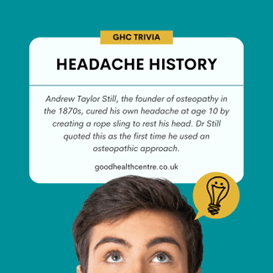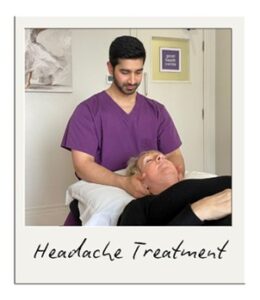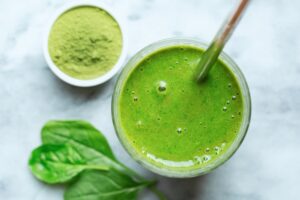Good Health Matters
February 2025
Focus on Headaches
In this month’s newsletter, we take a close look at treating headaches.
With around 16% of the global population experiencing a headache on any one day, we’re aware that many of you will be regularly struggling with headaches or migraines.
Headaches take many forms and have a lot of underlying causes. But therapies such as osteopathy and acupuncture are proving to be highly effective in treating certain kinds of headache.
In fact, research in the journal Evidence-Based Practice shows osteopathy to be better at reducing headache intensity and frequency than the medication amitriptyline.
Let’s explore headaches, then, and how we can help.
Good Health Centre: Treating Headaches

Common headache types
We all know what it’s like to have a headache. But for some, the burden of pain and disability can be difficult to bear.
There are more than 200 types of headache. However, by far the greatest majority fall into three categories: migraines, tension-type, and cervicogenic. These account for more than 40% of all headaches.
These headaches have a wide variety of causes, from hormonal changes or food triggers to stress and dehydration.
But there’s one common factor that can typically be found in all these headache types: problems with the upper neck.
Why is the upper neck important in headaches?
This is where we need to talk a little about neurology. The problem occurs with the way we’re wired.
Referred pain happens when pain arising in one place is projected to another – we feel it in a different area.
An example is the arm pain people sometimes feel during a heart attack. The pain arises in the heart, but the brain interprets it as coming from the left arm because the nerves from these two places enter the spinal cord at the same level.
Irritation in the upper neck can contribute to headaches because several nerves that supply the head enter the spinal cord here – at the same place as nerves from the structures of the upper neck itself.
The brain mixes up the signals, and ‘feels’ pain in the head that’s actually due to the upper neck.
And it is a vulnerable area. The neck has sacrificed stability for mobility, leaving it more likely to suffer strains and sprains. Trauma such as falls and whiplash injuries can damage the tiny joints and ligaments, leading to arthritic changes.
What’s more, the upper neck is often the ‘final point of compensation’ for our posture and lifestyles.
Inevitably, many of us adopt poor posture because of our daily habits, developing rounded shoulders, stiff back and tight muscles. When this happens, the upper neck must tilt our head upwards to keep our eyes level, meaning these tiny joints are often very compressed.
Dealing with tension and restriction in this area, then, can have a profound effect on reducing headache pain.
How can we help?
Here at GHC, our team regularly treats people suffering with headaches, successfully reducing the intensity and frequency of the pain. Many come to us because they don’t want to rely on medication, which carries the risk of rebound headaches.
Osteopathy
Osteopathic treatment aims to improve function in the upper neck and related areas.
Osteopaths can apply techniques to the muscles, such as massage, muscle energy techniques, trigger point treatment, and myofascial release, to ease tension and promote ease.
They can also mobilise or manipulate joints in the neck and back to release stiffness and encourage healthy movement throughout the spinal system.
And they can affect nerve function, too. Treatment can stimulate activity in the vagus nerve, a part of the autonomic nervous system. This modifies pain perception and improves blood flow.
In fact, muscle energy technique, a gentle method of increasing a muscle’s resting length, has been found to decrease the excitability of neurons in the central nervous system.
What’s more, osteopathic treatment is great at reducing stress – a major contributor to headache development.
Clinical trials have repeatedly confirmed the benefits of osteopathic treatment in easing the pain, frequency and duration of headaches.
Acupuncture
Alternatively, acupuncture offers a natural remedy for migraines and headaches. It has been shown to reduce the pain, duration and frequency of migraines, and lessen their recurrence.
The mechanism isn’t clear, but studies show it has a significantly better effect than sham acupuncture, suggesting that it’s more than a placebo.
It’s thought that acupuncture may stimulate the nervous, circulatory and immune systems, relieving pain and provoking a healing response.
And in the hands of a qualified acupuncturist, the technique carries no risk beyond mild side effects.
So don’t let headaches dominate your life: find ease at GHC with our qualified, experienced osteopaths and acupuncturists.
Learning at Good Health Centre
 Our team at GHC are always keen to sharpen their skills! And recently, we were given the chance to learn from personal experience. Osteopath Simon Barnard gave a talk on the advantages of partial knee replacement over total replacement, after benefitting from one himself.
Our team at GHC are always keen to sharpen their skills! And recently, we were given the chance to learn from personal experience. Osteopath Simon Barnard gave a talk on the advantages of partial knee replacement over total replacement, after benefitting from one himself.
Sharing our knowledge, skills and experience is just one way we stay up to date on best practice.
The Wellness Edit
Our top tips for managing headaches
Struggling to manage headaches or migraines? Try these simple self-help methods to alleviate the pain.
- Hydrate, hydrate, hydrate. Even mild dehydration can lead to a headache. The brain is mostly water, and dehydration can cause shrinkage, tensioning membranes, nerves and blood vessels. Keep taking in fluids throughout the day – don’t wait until you begin to feel thirsty.
- Try ginger tea. It doesn’t have to be plain water! Infuse fresh ginger in hot water for an anti-inflammatory and antioxidant hit. Plus, ginger’s active ingredients directly interact with serotonin receptors, mimicking the action of the feel-good neurotransmitter.
- Ease your stress. We can’t remove all the stress in our lives, but we can take positive steps to manage it. Learn breathwork techniques to control your stress in the moment. Keep up with social connections and seek support when you need to. Speak positively to yourself – look for the upside in every situation. Find time for exercise in your daily routine – it’s not only a great stressbuster, but it can boost your sleep too.
- Adjust your temperature. Some people find cool packs soothe their migraines, others find comfort in hot water bottles and warm layers.
- Use aromatherapy oils. Although there’s no scientific evidence for the use of essential oils, it’s common for people to find peppermint and lavender oils soothing during a migraine attack.
- Eat a banana, or other magnesium-rich foods. Magnesium deficiency is thought to be a factor in the development of migraines , so add soy products, nuts and seeds, peanut butter, dried apricots, beans and legumes, green leafy veg, and dark chocolate to your diet.
- Massage yourself. Firm, circular motion with your fingertips in certain spots can help relieve headache pain. Try the points where the bridge of your nose meets the ridge of your eyebrows, under the base of the skull at the back of the neck, or at the area where the shoulder curves into the neck. Apply small circular motions with firm pressure for about a minute in each area.
We can support you with headache management. Try out osteopathy, massage or acupuncture as natural ways to reduce the frequency and intensity of your headaches.
Soothing Smoothie
With a combination of fibre, healthy fats, vitamins and antioxidants, this smoothie from The Dizzy Cook is a good choice for soothing headaches. It includes ingredients that are anti-inflammatory and, of course, some ginger for its beneficial effect on headache pain and nausea.

| Ingredients | Method | |
| · 120g chopped pear, skin on
· 2 tsp grated ginger · 25g spinach or rocket leaves · 180g oat milk · 2 tsp hemp or chia seeds · 1 tsp honey or maple syrup · 125g ice |
Add the pear, ginger, spinach, milk and seeds to a blender and whizz till smooth.
Add the ice and blend again till frothy. Add honey or syrup to sweeten to taste. |
Clinic Opening Times
We offer appointments from 8am to 7pm or 7:30pm on weekdays, except Tuesday when we open late till 9pm. And on Saturdays we’re here from 9am to 3pm. Here is a handy reminder of our opening hours:
| MONDAY | 8am to 7pm |
| TUESDAY | 8am to 9pm |
| WEDNESDAY | 8am to 7pm |
| THURSDAY | 8am to 7:30pm |
| FRIDAY | 8am to 7pm |
| SATURDAY | 9am to 3pm |
| SUNDAY | CLOSED |
We look forward to easing your headaches, or any other pain you may have! Get in touch today.
With best wishes from all the team at GHC.
[Book with one of our team button]
**Good Health Centre: enhancing good health and vitality in Yorkshire for over 30 years**